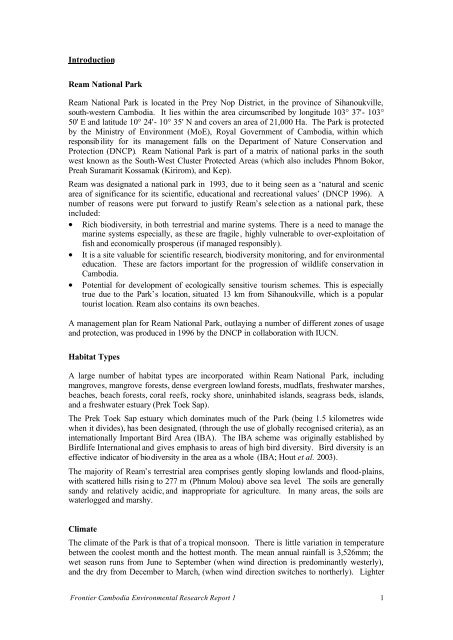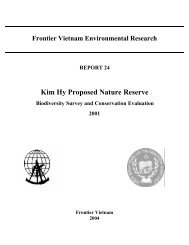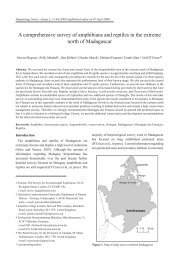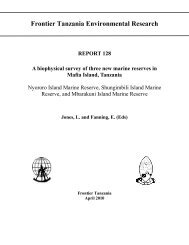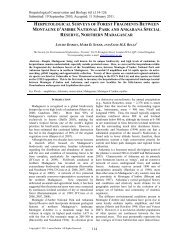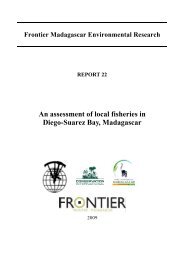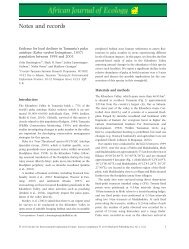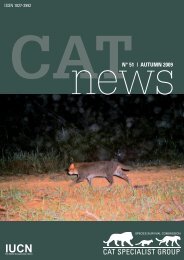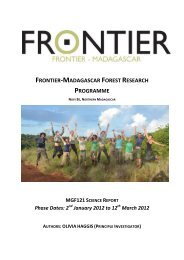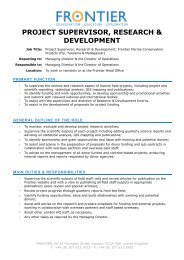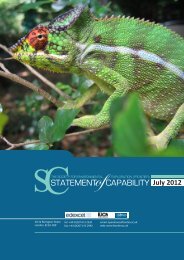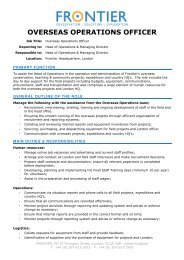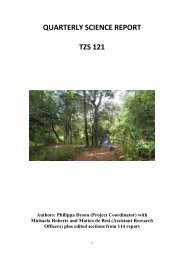Ream National Park Twelve Month Report
Ream National Park Twelve Month Report
Ream National Park Twelve Month Report
You also want an ePaper? Increase the reach of your titles
YUMPU automatically turns print PDFs into web optimized ePapers that Google loves.
Introduction<br />
<strong>Ream</strong> <strong>National</strong> <strong>Park</strong><br />
<strong>Ream</strong> <strong>National</strong> <strong>Park</strong> is located in the Prey Nop District, in the province of Sihanoukville,<br />
south-western Cambodia. It lies within the area circumscribed by longitude 103° 37'- 103°<br />
50' E and latitude 10° 24'- 10° 35' N and covers an area of 21,000 Ha. The <strong>Park</strong> is protected<br />
by the Ministry of Environment (MoE), Royal Government of Cambodia, within which<br />
responsibility for its management falls on the Department of Nature Conservation and<br />
Protection (DNCP). <strong>Ream</strong> <strong>National</strong> <strong>Park</strong> is part of a matrix of national parks in the south<br />
west known as the South-West Cluster Protected Areas (which also includes Phnom Bokor,<br />
Preah Suramarit Kossamak (Kirirom), and Kep).<br />
<strong>Ream</strong> was designated a national park in 1993, due to it being seen as a ‘natural and scenic<br />
area of significance for its scientific, educational and recreational values’ (DNCP 1996). A<br />
number of reasons were put forward to justify <strong>Ream</strong>’s selection as a national park, these<br />
included:<br />
• Rich biodiversity, in both terrestrial and marine systems. There is a need to manage the<br />
marine systems especially, as these are fragile, highly vulnerable to over-exploitation of<br />
fish and economically prosperous (if managed responsibly).<br />
• It is a site valuable for scientific research, biodiversity monitoring, and for environmental<br />
education. These are factors important for the progression of wildlife conservation in<br />
Cambodia.<br />
• Potential for development of ecologically sensitive tourism schemes. This is especially<br />
true due to the <strong>Park</strong>’s location, situated 13 km from Sihanoukville, which is a popular<br />
tourist location. <strong>Ream</strong> also contains its own beaches.<br />
A management plan for <strong>Ream</strong> <strong>National</strong> <strong>Park</strong>, outlaying a number of different zones of usage<br />
and protection, was produced in 1996 by the DNCP in collaboration with IUCN.<br />
Habitat Types<br />
A large number of habitat types are incorporated within <strong>Ream</strong> <strong>National</strong> <strong>Park</strong>, including<br />
mangroves, mangrove forests, dense evergreen lowland forests, mudflats, freshwater marshes,<br />
beaches, beach forests, coral reefs, rocky shore, uninhabited islands, seagrass beds, islands,<br />
and a freshwater estuary (Prek Toek Sap).<br />
The Prek Toek Sap estuary which dominates much of the <strong>Park</strong> (being 1.5 kilometres wide<br />
when it divides), has been designated, (through the use of globally recognised criteria), as an<br />
internationally Important Bird Area (IBA). The IBA scheme was originally established by<br />
Birdlife International and gives emphasis to areas of high bird diversity. Bird diversity is an<br />
effective indicator of biodiversity in the area as a whole (IBA; Hout et al. 2003).<br />
The majority of <strong>Ream</strong>’s terrestrial area comprises gently sloping lowlands and flood-plains,<br />
with scattered hills rising to 277 m (Phnum Molou) above sea level. The soils are generally<br />
sandy and relatively acidic, and inappropriate for agriculture. In many areas, the soils are<br />
waterlogged and marshy.<br />
Climate<br />
The climate of the <strong>Park</strong> is that of a tropical monsoon. There is little variation in temperature<br />
between the coolest month and the hottest month. The mean annual rainfall is 3,526mm; the<br />
wet season runs from June to September (when wind direction is predominantly westerly),<br />
and the dry from December to March, (when wind direction switches to northerly). Lighter<br />
Frontier Cambodia Environmental Research <strong>Report</strong> 1<br />
1


